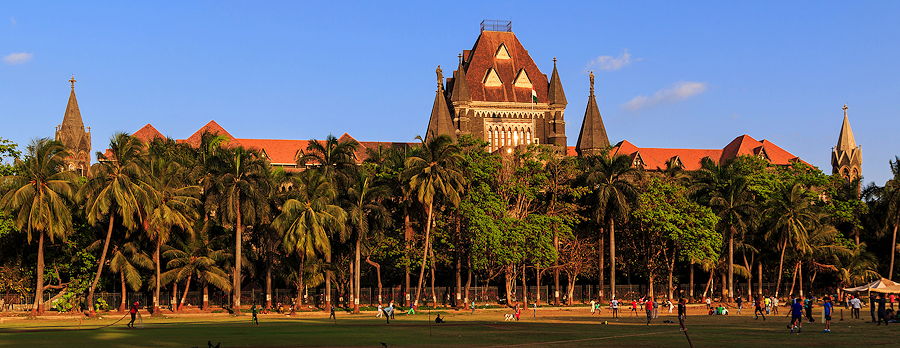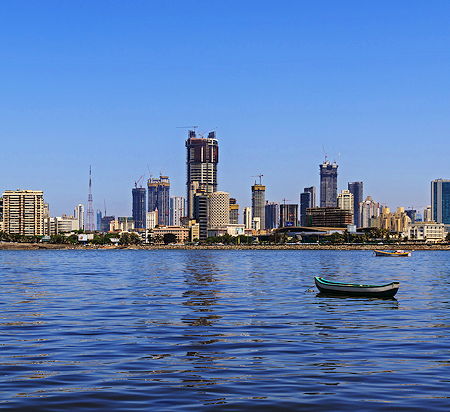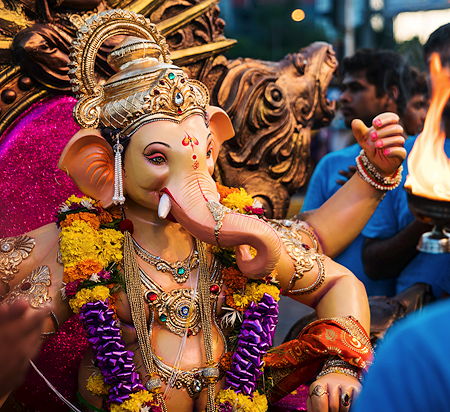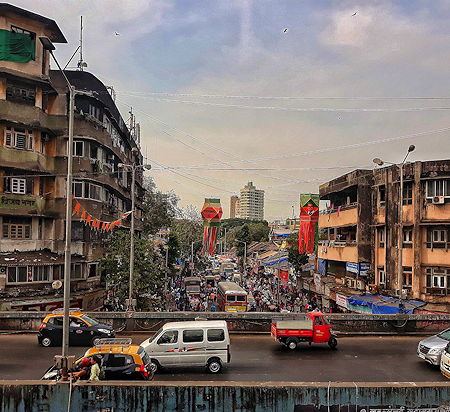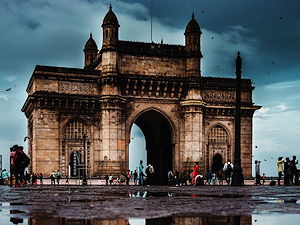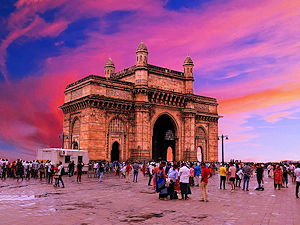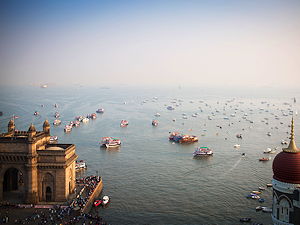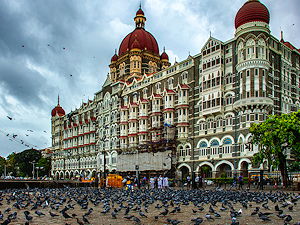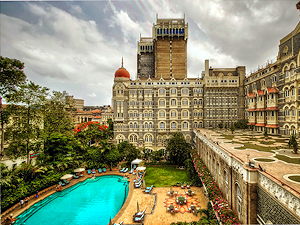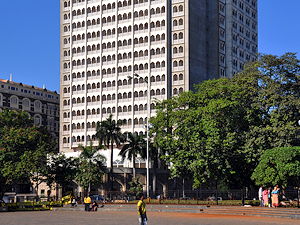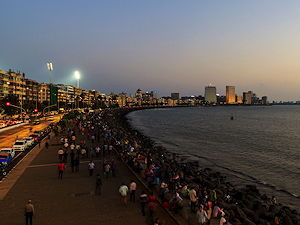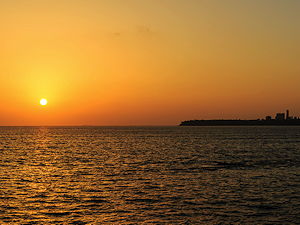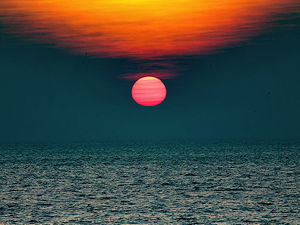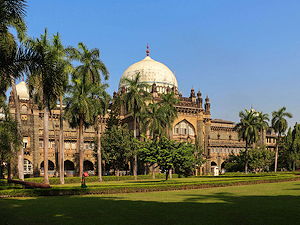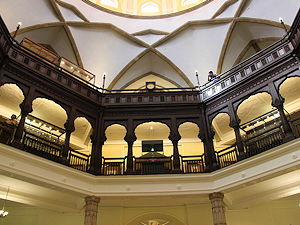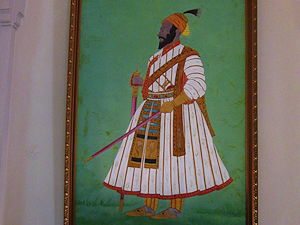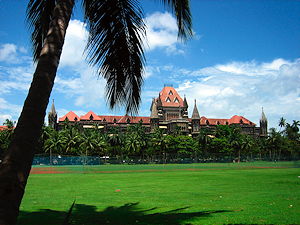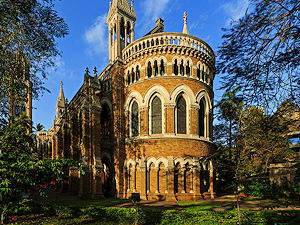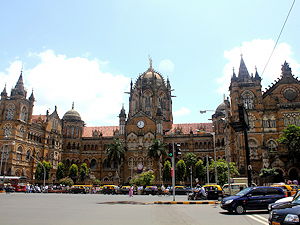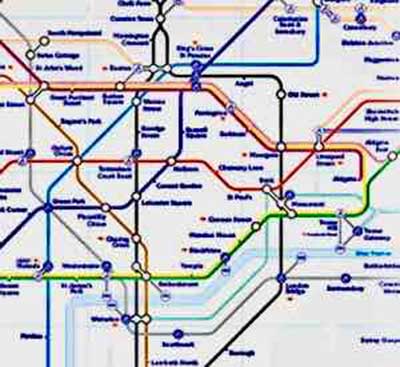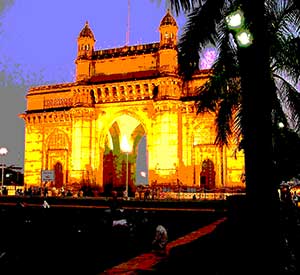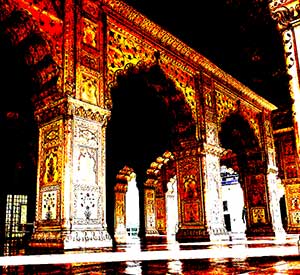Things to do in Mumbai, India
Mumbai, India's largest city, is the country's capital of finance, culture and entertainment.
It has an urban area that is home to about 20 million, a number that is rapidly increasing. It is here that you will find the Reserve Bank of India and the Indian Stock Exchange. The city accounts for a large proportion of India's exports and tax revenue. And Mumbai is home to both the Bollywood film industry and the Indian Premier League, two of India's most famous exports.
Mumbai also has plenty to offer the visitor. Its varied history - it was controlled by the Portuguese and then the British before independence came in 1947 - has contributed to an eclectic mix of classical, Indian, art-deco and modern buildings. The jewels in the architectural crown are Mumbai University, the High Court and the Chhatrapati Shivaji railway station (the last a World Heritage Site). They can be seen on a walking tour of south Mumbai.
Other Mumbai highlights include the Gateway of India (erected in the early 20th century to commemorate the first visit of a British monarch to India), the Elephanta Caves, the Taj Mahal Palace Hotel (possibly the finest hotel in the world), the Museum, Mumbai (India's premier museum, offering a particular good natural history section), the Hanging Gardens, and Marine Drive (India's most famous street, lined with hotels such as the Oberoi, cricket grounds such as the Wankhede Stadium, and Chowpatti Beach).
1. The Gateway of India
The Gateway of India is an impressive yellow basalt monument regarded as the iconic symbol of Mumbai.
Designed by Scottish architect George Wittet, and built between 1920 and 1924, the Gateway commemorated the 1911 visit of King George V and Queen Mary to India (the first time a British monarch had visited its largest colony). During British rule it was used for ceremonies marking the arrival in India of new Viceroys and Governors of Bombay.
The Gateway is also famous for being the place where the last British troops to leave India, the First Battalion of the Somerset Light Infantry, departed the country on 28 February 1948, marking the end of British rule.
The Gateway, built in the style of 16th century Gujurati architecture, is 85 feet high. It comprises a central dome with a diameter of 48 feet, with large open halls on each side (which can each accommodate functions for 600 people).
The best time to see the Gateway is first thing in the morning, when there are next to no tourists here. It is open by 7am.
Attractions around the Gateway include the Taj Mahal Palace Hotel, looking at the sunrise over the Arabian sea, taking in the colourful fishing and tourist boats, buying a Rs10 Chai from one of the numerous vendors walking around the area, and taking a quick peek at the statues of Shevaji Mamaraj and Swami Vivekananda in the small parks found nearby. MAP
2. The Taj Mahal Palace
The Taj Mahal Palace Hotel is the best hotel in Mumbai and one of the finest hotels in the world. Stay here if you can. And if you can't, stop in for a meal or a drink.
History
The Taj, owned by the Tata group of companies, was commissioned by Jamsetji Tata and opened for business in December 1903. Legend has it that Tata decided to build the Taj after he was turned away from a nearby 'whites only' hotel. But the truth is likely to be more mundane: Tata listened when the editor of the Times of India said that a hotel "worthy of Bombay" was required.
The Taj was in one respect fortunate: the Gateway of India was built within metres of its front doors 20 years after they opened. It is, then, at the very epicentre of Mumbai. It has been upgraded and refurbished over the years, in particular by the construction of the Taj Mahal Tower - a 20 storey additional wing - in 1973.
The Taj was targeted by the 2008 attack on Mumbai by Pakistani terrorist group Lashkar-e-Taiba. Thirty-one of the c. 450 guests staying at the hotel died, as gunmen rampaged through its corridors and rooms. The names of the victims are engraved in a memorial garden found off the hotel's lobby.
Rooms
The Taj is a true five-star hotel, offering 560 rooms including 44 suites. It has about 1,500 staff (including 35 butlers, one of the hotel's attractions since it opened at the beginning of the 20th century). The hotel's rooms include the Ravi Shankar and Rajput Suites, both offering 140 square metres of living space. Another must-see is the Taj's magnificent 6-floor floating Grand Staircase (pictured).
The piece de resistance is the Tata Suite, complete with its own crystal chandeliers, Italian marble, gold-threaded upholstery, Jiva spa (with steam room, sauna and two masseurs), personal chef and butler and Indian masterpieces by MF Husain, Ram Kumar and Laxman Shreshtha. The suite is 465 square metres in size and offers panoramic views of the Gateway of India and the Arabian Sea.
Unsurprisingly, the Taj has proved popular with the powerful, rich and famous. Notable guests over the years have included Queen Elizabeth II, Neil Armstrong, Barack Obama, Bill Clinton, Prince William, John Lennon and Yoko Ono, Ravi Shankar, Mick Jagger, Alfred Hitchcock, Roger Moore and Sachin Tendulkar.
Eateries
The Taj offers nine different eating options. Wasabi by Morimoto is its premier restaurant. Serving Japanese food, Wasabi was rated as one of Asia's 50 best restaurants in 2013.
Other restaurants serving regional food are Golden Dragon (Chinese), Masala Craft (Indian), and Souk (Middle Eastern; found at the top of the Taj Majal Tower). Shamiana, near the central lobby, serves international fare 24 hours a day; whilst Aquarius by the Taj's pool offers fantastic barbeque in the evenings.
For teatime, check our the Sea Lounge on the first floor: in addition to the finest quality teas, coffees and delicacies, you will be able to look out over the Arabian Sea and Gateway of India. And for a drink, you should choose the Harbour Bar: Mumbai's first licenced bar, this joint is known for its fine malts and 'From the Harbour since 1933' cocktail (from the Prohibition Era). Finally, La Patisserie is the Taj's in-house bakery and delicatessen.
Other amenities
As one would expect of a leading five-star hotel, the Taj's other facilities are also top-drawer. It has an excellent spa and gym; a well-equipped business centre; and a large (30 x 20 metre) central swimming pool. Its lobby level is home to two shopping arcades selling high-end products such as Luis Vuitton handbags and Mont Blanc pens. Its reception desk has three large MF Husain paintings found behind it. And it even has its very own art gallery. MAP
3. Marine Drive
Marine Drive, a 3.5 kilometre long walkway in south Mumbai, is one of the city's most stunning roads.
Shaped like an inverted C and linking Nariman Point in the south with Malabar Hills further north, Marine Drive is the perfect place for an early morning or evening stroll.
The Drive, whose full name is Netaji Subhash Chandra Bose Road, is more affectionately known as the Queen's Necklace: the lights from adjacent buildings resemble pearls at night.
Nariman Point
Nariman Point, at the southern tip of the Drive, offers great views over the Back Bay (and fishing boats bobbing in the tide) as well as to the skyscrapers of Malabar Hill across the water.
Start your walk by taking in the Oberoi Hotel on your right: this is Mumbai's second most famous hotel, after the Taj Palace, and has an impressive central lobby which you can soak up whilst sipping a drink at the Champagne Bar.
Continue northwards along the tree-lined walkway and notice the Trident Hotel, the Hotel Marine Plaza and the Brabourne Stadium (an international cricket ground) in turn.
Wankhede Stadium
The next major landmark is the Wankhede Stadium, Mumbai's premier cricket ground. Built in 1974 after a dispute between rival cricket administrators, the Wankhede has a capacity of 33,108 and is now invariably used for India's international matches held in Mumbai.
It was here that India defeated Sri Lanka at the final of the 2011 cricket world cup, Sachin Tendulkar's last international match.
Continue north to see the Mumbai University Cricket Ground, and a number of Gymkhana's affiliated with the Hindu, Muslim and Parsi religions. You'll also be impressed by a number of Art Deco buildings, generally constructed by rich Parsis.
Chowpatty Beach
As you continue northwards, you'll see the Marine Drive Jogging Track close to the water's edge. The final main attraction is Chowpatty Beach (or Girgaum Chowpatty to give it its Indian name) itself. It is known for its golden sands and numerous restaurants and street vendors. But don't under any circumstances think about swimming here: the water is horribly polluted with sewage. MAP
4. The Museum, Mumbai
The Museum, Mumbai (fka the Prince of Wales Museum) is the best museum in India.
Opened in January 1922, to commemorate the first visit of the Prince of Wales, the museum is these days styled the Chhatrapati Shivaji Maharaj Vastu Sangrahalaya Museum or (more sensibly) just The Museum, Mumbai.
It displays around 50,000 artefacts in an impressive George Wittet-designed Indo-Saracenic building with sumptuous grounds. They are arranged into three sections: Natural History, Art and Archaeology.
Natural History
The Museum's natural history collection, formed with the assistance of the Bombay Natural History Society, is as good as any in the world (including West London's Natural History Museum). Focusing on animals from the sub-continent, the exhibitions on the Museum's ground floor are arranged into bird, mammal and fish/reptile galleries.
Highlights include a white tiger, lion, hippo, whale, varieties of vulture, and king cobra. The standard of curatorship is also high. You can, for example, learn how to distinguish venomous and non-venomous snakes from the scales on their bellies.
Other sections
The art section, formed from donations from the likes of Sir Ratan Tata, includes works from the Mughai, Rajastahni and Deccani schools of painting. Other attractions include European paintings, Chinese porcelain and an 'arms and armour' gallery.
The recently renovated sculpture gallery, close to the Museum's entrance on the ground floor, is also well worth a look. It displays iconography from the Hindu, Jain and Buddhist religions.
Finish your visit by taking in the immaculately presented grounds, which include formal gardens, a number of lovely palms and a statue of the Prince of Wales (later King George V). The Museum also offers a good shop and cafe.
where? 159-161, Mahatma Gandhi Road, Fort, Mumbai, Maharashtra 400032. MAP
when? 10.15am to 6pm, seven days a week.
£$€¥ Rs650 for foreign adults (R100 for Indian adults).
5. Walking tour of downtown Mumbai
Get your bearings by following our recommended 2-3 hour walk around Mumbai (best undertaken in the early morning, when it is cool and the streets are quiet).
Gateway of India
Start from the Gateway of India, described above. Walk past the Taj Palace Hotel (on your right), following the P J Ramchandani Marg. You'll enjoy the Arabian Sea and the many fishing and tourist boats moored nearby.
Continue around a right-hand bend and keep going until you hit a T-junction. Turn right again and walk up the Shahid Bhagat Singh Rd until you reach Best Marg, where you should turn left. Continue for about 300 metres and at the crossroads bear slightly to your right onto Cooperage Road.
You will see a Football Ground on your right hand side (see if you can pop in - it often has competitive matches on early in the morning). Continue to the main junction and head over the road onto the Oval Maiden park.
The Oval Maiden
The Oval Maiden is a large rectangular sports ground that is heavily used - predominantly for cricket practice - in the early morning. Walk up the right-hand side of the Maiden until you can see an impressive set of classical buildings clustered around a tall central clock tower.
This is Mumbai University, established in 1857 and now one of the largest universities in the world. Continue in the same direction, taking in the Bombay High Court (the next significant building on your right), until you hit the V N Road.
Take a right and continue straight until you reach the Flora Fountain (built in 1864 and named after the eponymous Roman goddess). Then proceed up Dr Dahabhai Naoroji Road until you reach Mumbai Railway Station.
Chhatrapati Railway Station
Chattrapati Railway Station, or to give it its full title the Chhatrapati Shivaji Maharaj Terminus, is an historic building and UNESCO World Heritage Site. Its name was changed from Victoria Terminus in 1996, to honour the founder of the Maratha empire.
Designed by Frederick William Stevens in a mix of Gothic Revival/Indian/Italianate styles, the station was built in 1887 to celebrate Victoria's Golden Jubilee.
Be warned: it will be bustling.But marvel at the building's facade and force your way inside to witness the hubbub of a station used by about a million people each day.
Once you've finished looking around, retrace your steps to VN Road and follow it west until you hit Marine Drive.
Marine Drive
We describe Marine Drive above.Cross the Drive, turn left and head down the walkway.You will appreciate the views and pretty trees growing by the side of the road. This is also a great place to people watch: you'll find locals jogging, power-walking and meditating. This is also a good spot for a break, perhaps accompanied by a Rs10 shot of Chai purchased from one of the many vendors walking up and down the Drive.
If you are feeling energetic, head to Nariman Point at the southernmost end of Marine Drive. You'll see the impressive Trident and Oberoi hotels as you go.
Getting back
Turn off Marine Drive and head down Madame Cama Road, back towards the Oval Maiden. You'll notice a number of government buildings on your right-hand side (they are not open to the public). Continue past the Oval Maiden until you reach a large intersection. You'll here find the National Gallery of Modern Art and the Mumbai Museum, though they may not have opened yet. Take the third exit and head the short distance back to the Gateway of India. MAP
